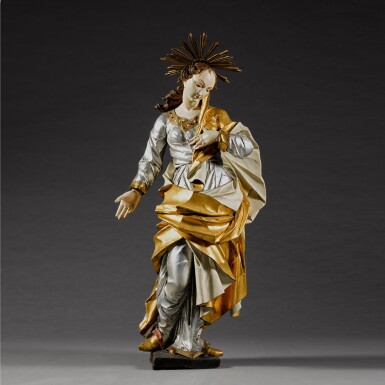
JOHANN KASPAR HIERNLE | VIRGIN
Lot Closed
May 27, 02:17 PM GMT
Estimate
20,000 - 30,000 GBP
Lot Details
Description
JOHANN KASPAR HIERNLE
1710-1750
VIRGIN
gilt, silvered and polychromed limewood
height: 131.5cm., 51¾in.; 139cm., 54¾in. including halo
Executed in Mainz, Germany, circa 1750.
To view shipping calculator, please click here.
By repute the Church of St. Stephan, Mainz
Rear courtyard, Himmelgasse 11, until 1905
Acquired for a church in Mainz-Amöneburg
Mr. Leonhard, Höchst
Art market, Frankfurt
Georg Hartmann, Frankfurt
On loan to the Liebieghaus, Frankfurt, 1978-1983
On loan to the Landesmuseum Mainz, 1983-2014 (inv. no. DL 2000/11)
Thence by descent, private collection, Germany
Sotheby's, London, 3 December 2014, lot 102
Ernst Neeb, Verzeichnis der Kunstdenkmäler der Stadt Mainz, I. Privatbesitz, Mainz, 1905, p. 52
Peter Metz, Mainzer Rokokoplastik, Giessen, 1927, p. 24
Ludwig Döry, 'Sebastian and Johann Kaspar Hiernle, Mainzer Bildhauer', Mainzer Zeitschrift. Mittelrheinisches Jahrbuch für Archäologie, Kunst und Geschichte 79/80, 1984/1985, pp. 219-220 and 232, no. A 24, fig. 14
Nicole Beyer, Skulpturen des 17. und 18. Jahrhunderts im Landesmuseum Mainz, Mainz, 2001, pp. 112-113, no. 64
This impressive German Rococo statue of the Virgin was attributed to Johann Kaspar Hiernle by Ludwig Baron Döry in his seminal 1984 essay on the sculptor and his brother Sebastian (d. 1755) (Döry, op. cit., pp. 219-220, 232). It was on long-term loan to the Landesmuseum, Mainz, before being sold at Sotheby’s in 2014.
Johann Kaspar Hiernle was the son of the celebrated late Baroque sculptor Franz Matthias Hiernle (1677-1732), a native of Bavaria who moved to Mainz and became court sculptor to Elector Lothar Franz von Schönborn (1655-1729). His success led to the creation of a dynasty for the family, with his sons Johann Kaspar and Sebastian receiving notable commissions in their own right.
The present figure is a particularly beautiful example of Johann Kaspar's work, with Döry commenting that, in its delicacy, grace and unity, it counts among the sculptor’s masterpieces (Döry, op. cit., p. 219). The Virgin is thought to have been made for the church of St Stephan, Mainz, which provided Johann Kaspar with numerous important commissions, including a statue of St. Bonifatius (for a complete list see Döry, op. cit., p. 232). In its facial physiognomy, with oval shaped head and long neck, it finds a close parallel in the sculptor's Immaculata surmounting the Quintin-Kirchhof in Mainz (1752) (Döry, op. cit., p. 209). Particularly attractive is the great swathe of cartaceous drapery which envelops the figure in what Dory describes as a 'chalice', with the effect that she appears almost pregnant (Döry, op. cit., p. 219). With its striking gold and silver polychromy, the Virgin is a powerful and beguiling illustration of German Rococo sculpture.
